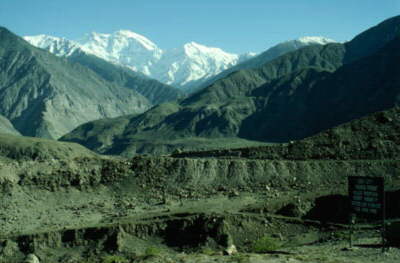Is there any significant strike-slip offset on the western margin
of the Nanga Parbat-Haramosh Massif (NPHM)?
 If
the NPHM were due to indentation tectonics, evidence of significant strike-slip
should be found on both margins of the massif. Mylonites of the MMT zone
do show apparent strike-slip ductile components, of the correct complementary
sense, but these do not have to be from indentation, and alternatively
could be due to refolding of MMT overthrusting fabrics during the rise
of the antiformal NPHM. Brittle faults, which also have permitted rise
of the NPHM, are abundant in a zone on and near the western margin; our
data indicate that these have overwhelmingly dominant dip-slip motion.
Fibre-coated slip surfaces with dominant strike-slip are only found as
subsidiary features in the highly fractured accommodation zones adjacent
to large brittle faults, including the Sassi-Shahbatot Fault. We suggest
that the apparent large right-lateral offset of
the Indus River across that fault is not due to strike-slip displacement.
The eastern margin of the massif has much less brittle faulting than the
western marginal zone; it is mostly a zone of flexure of the MMT to moderate
and steep easterly dips. Those brittle faults that do occur here have dominant
dip-slip displacements permitting rise of the NPHM.
If
the NPHM were due to indentation tectonics, evidence of significant strike-slip
should be found on both margins of the massif. Mylonites of the MMT zone
do show apparent strike-slip ductile components, of the correct complementary
sense, but these do not have to be from indentation, and alternatively
could be due to refolding of MMT overthrusting fabrics during the rise
of the antiformal NPHM. Brittle faults, which also have permitted rise
of the NPHM, are abundant in a zone on and near the western margin; our
data indicate that these have overwhelmingly dominant dip-slip motion.
Fibre-coated slip surfaces with dominant strike-slip are only found as
subsidiary features in the highly fractured accommodation zones adjacent
to large brittle faults, including the Sassi-Shahbatot Fault. We suggest
that the apparent large right-lateral offset of
the Indus River across that fault is not due to strike-slip displacement.
The eastern margin of the massif has much less brittle faulting than the
western marginal zone; it is mostly a zone of flexure of the MMT to moderate
and steep easterly dips. Those brittle faults that do occur here have dominant
dip-slip displacements permitting rise of the NPHM.
Return to Abstract/Index
 If
the NPHM were due to indentation tectonics, evidence of significant strike-slip
should be found on both margins of the massif. Mylonites of the MMT zone
do show apparent strike-slip ductile components, of the correct complementary
sense, but these do not have to be from indentation, and alternatively
could be due to refolding of MMT overthrusting fabrics during the rise
of the antiformal NPHM. Brittle faults, which also have permitted rise
of the NPHM, are abundant in a zone on and near the western margin; our
data indicate that these have overwhelmingly dominant dip-slip motion.
Fibre-coated slip surfaces with dominant strike-slip are only found as
subsidiary features in the highly fractured accommodation zones adjacent
to large brittle faults, including the Sassi-Shahbatot Fault. We suggest
that the apparent large right-lateral offset of
the Indus River across that fault is not due to strike-slip displacement.
The eastern margin of the massif has much less brittle faulting than the
western marginal zone; it is mostly a zone of flexure of the MMT to moderate
and steep easterly dips. Those brittle faults that do occur here have dominant
dip-slip displacements permitting rise of the NPHM.
If
the NPHM were due to indentation tectonics, evidence of significant strike-slip
should be found on both margins of the massif. Mylonites of the MMT zone
do show apparent strike-slip ductile components, of the correct complementary
sense, but these do not have to be from indentation, and alternatively
could be due to refolding of MMT overthrusting fabrics during the rise
of the antiformal NPHM. Brittle faults, which also have permitted rise
of the NPHM, are abundant in a zone on and near the western margin; our
data indicate that these have overwhelmingly dominant dip-slip motion.
Fibre-coated slip surfaces with dominant strike-slip are only found as
subsidiary features in the highly fractured accommodation zones adjacent
to large brittle faults, including the Sassi-Shahbatot Fault. We suggest
that the apparent large right-lateral offset of
the Indus River across that fault is not due to strike-slip displacement.
The eastern margin of the massif has much less brittle faulting than the
western marginal zone; it is mostly a zone of flexure of the MMT to moderate
and steep easterly dips. Those brittle faults that do occur here have dominant
dip-slip displacements permitting rise of the NPHM.